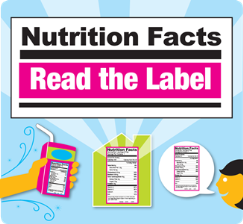How to read a food label ? 
Reading a food label is an important skill for making informed and healthy food choices. Food labels provide information about the nutritional content and ingredients of a product. Here’s a step-by-step guide on how to read a food label:
-
- Start with the Serving Size: This is usually at the top of the label. It tells you how much one serving of the product is. All the other information on the label, such as calories and nutrients, is based on this serving size. Make sure to compare this to the amount you actually eat.
- Check the Calories: The next line typically lists the number of calories per serving. This tells you how much energy you will get from one serving of the food.
- Look at the Nutrients: Below the calories, you’ll find a list of nutrients. The most important ones to pay attention to include:
- Total Fat: This section includes the total fat content, and below it, you’ll usually find a breakdown of different types of fats (saturated and trans fats). Aim for foods that are low in saturated and trans fats.
- Cholesterol and Sodium: These values are important for heart health. High levels of cholesterol and sodium can increase your risk of heart disease, so try to limit these nutrients, especially if you have specific dietary restrictions.
- Total Carbohydrates: This section includes both sugars and dietary fiber. Look for products that are higher in dietary fiber and lower in added sugars. Fiber is beneficial for digestion and can help control blood sugar levels.
- Protein: This section lists the amount of protein in one serving. Protein is important for muscle building and repair.
- Check the Percent Daily Value (%DV): On the right side of the label, you’ll see %DV values for each nutrient. These percentages are based on a daily diet of 2,000 calories, which is the general daily calorie intake used on food labels. The %DV helps you understand how a serving of the food fits into your overall daily nutrient needs. For example, if a product has 20% DV for calcium, one serving provides 20% of your daily calcium requirement.
- Pay Attention to Ingredients: The ingredients list can be found on the package, usually beneath the nutrition facts panel. Ingredients are listed in descending order by weight, with the main ingredient listed first. Be cautious of products with a long list of artificial additives, preservatives, or ingredients you can’t pronounce.
- Check for Allergens: Food labels should also indicate common allergens like wheat, soy, milk, eggs, nuts, and shellfish. If you have food allergies, this information is crucial.
- Be Wary of Health Claims: Be cautious of marketing claims on the front of the package. Terms like “low fat,” “sugar-free,” or “natural” may not always reflect the overall healthiness of the product. Always refer to the nutrition facts and ingredients list for the most accurate information.
- Consider Your Dietary Needs: Finally, consider your specific dietary needs and goals. For example, if you’re trying to lose weight, you may want to pay close attention to calories and portion sizes. If you have dietary restrictions or health concerns, focus on the nutrients that matter most to you.
By following these steps and understanding the information on food labels, you can make healthier and more informed choices when selecting products at the grocery store.
Education Fit Blog for Personal Trainers Education Written by Joe Antouri / CEO PROPTA. All rights reserved.
WorldWide Institute for Fitness and Nutrition Education and Certification.
¿Cómo leer la etiqueta de un alimento? 
Aprender a leer una etiqueta de alimentos es una habilidad importante para tomar decisiones informadas y saludables en cuanto a la comida. Las etiquetas de alimentos proporcionan información sobre el contenido nutricional e ingredientes de un producto. Aquí tienes una guía paso a paso sobre cómo leer una etiqueta de alimentos:
-
- Comienza con el Tamaño de la Porción: Esto suele estar en la parte superior de la etiqueta. Te indica cuánta cantidad de producto constituye una porción. Toda la demás información en la etiqueta, como calorías y nutrientes, se basa en este tamaño de porción. Asegúrate de compararlo con la cantidad que realmente consumes.
- Verifica las Calorías: La siguiente línea generalmente muestra el número de calorías por porción. Esto te dice cuánta energía obtendrás de una porción del alimento.
- Mira los Nutrientes: Debajo de las calorías, encontrarás una lista de nutrientes. Los más importantes a los que debes prestar atención incluyen:
- Grasa Total: Esta sección incluye el contenido total de grasa y, debajo de ella, generalmente encontrarás una desglose de diferentes tipos de grasas (grasas saturadas y grasas trans). Busca alimentos bajos en grasas saturadas y grasas trans.
- Colesterol y Sodio: Estos valores son importantes para la salud del corazón. Niveles altos de colesterol y sodio pueden aumentar tu riesgo de enfermedades cardíacas, así que trata de limitar estos nutrientes, especialmente si tienes restricciones dietéticas específicas.
- Carbohidratos Totales: Esta sección incluye tanto azúcares como fibra dietética. Busca productos que sean más altos en fibra dietética y bajos en azúcares agregados. La fibra es beneficiosa para la digestión y puede ayudar a controlar los niveles de azúcar en la sangre.
- Proteína: Esta sección lista la cantidad de proteína en una porción. La proteína es importante para la construcción y reparación de los músculos.
- Verifica el Porcentaje del Valor Diario (%VD): En el lado derecho de la etiqueta, verás valores %VD para cada nutriente. Estos porcentajes se basan en una dieta diaria de 2,000 calorías, que es la ingesta calórica diaria general utilizada en las etiquetas de alimentos. El %VD te ayuda a entender cómo una porción del alimento se ajusta a tus necesidades nutricionales diarias en general. Por ejemplo, si un producto tiene un 20% de %VD para el calcio, una porción proporciona el 20% de tu requerimiento diario de calcio.
- Presta Atención a los Ingredientes: La lista de ingredientes se encuentra en el paquete, generalmente debajo del panel de información nutricional. Los ingredientes se enumeran en orden descendente según su peso, con el ingrediente principal en primer lugar. Ten cuidado con los productos con una larga lista de aditivos artificiales, conservantes o ingredientes que no puedas pronunciar.
- Busca Alergenos: Las etiquetas de alimentos también deben indicar alérgenos comunes como trigo, soja, leche, huevos, nueces y mariscos. Si tienes alergias alimentarias, esta información es crucial.
- Ten Cuidado con las Reivindicaciones de Salud: Sé cauteloso con las afirmaciones de marketing en la parte frontal del paquete. Términos como “bajo en grasa”, “sin azúcar” o “natural” no siempre reflejan la salud general del producto. Siempre consulta la información nutricional y la lista de ingredientes para obtener la información más precisa.
- Considera tus Necesidades Dietéticas: Finalmente, ten en cuenta tus necesidades dietéticas y objetivos específicos. Por ejemplo, si estás tratando de perder peso, es posible que desees prestar mucha atención a las calorías y al tamaño de las porciones. Si tienes restricciones dietéticas o preocupaciones de salud, enfócate en los nutrientes que son más importantes para ti.
Siguiendo estos pasos y entendiendo la información en las etiquetas de alimentos, puedes tomar decisiones más saludables e informadas al seleccionar productos en el supermercado.
Blog de educación para entrenadores personales Educación Escrito por Joe Antouri / CEO PROPTA. Todos los derechos reservados.
Instituto Mundial para la Educación y Certificación en Fitness y Nutrición.

